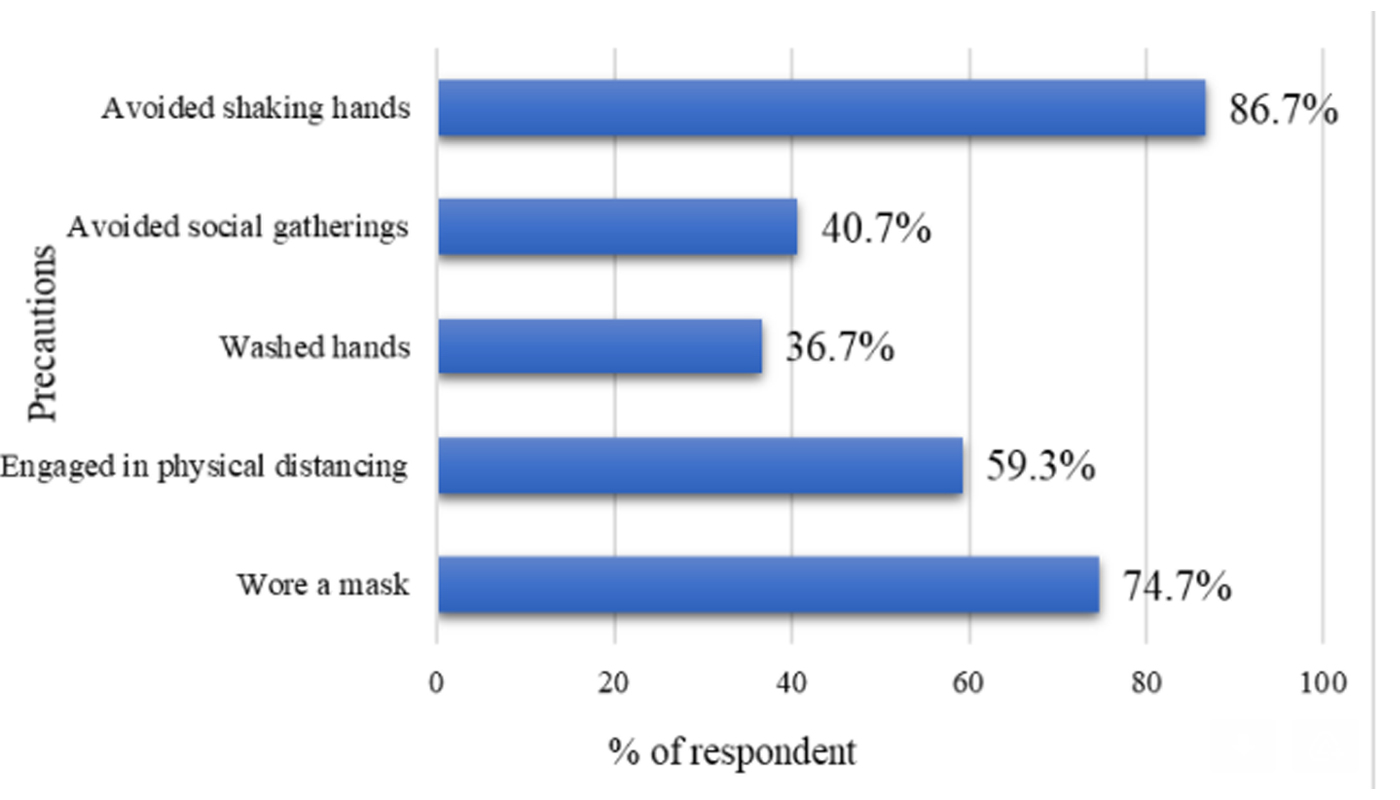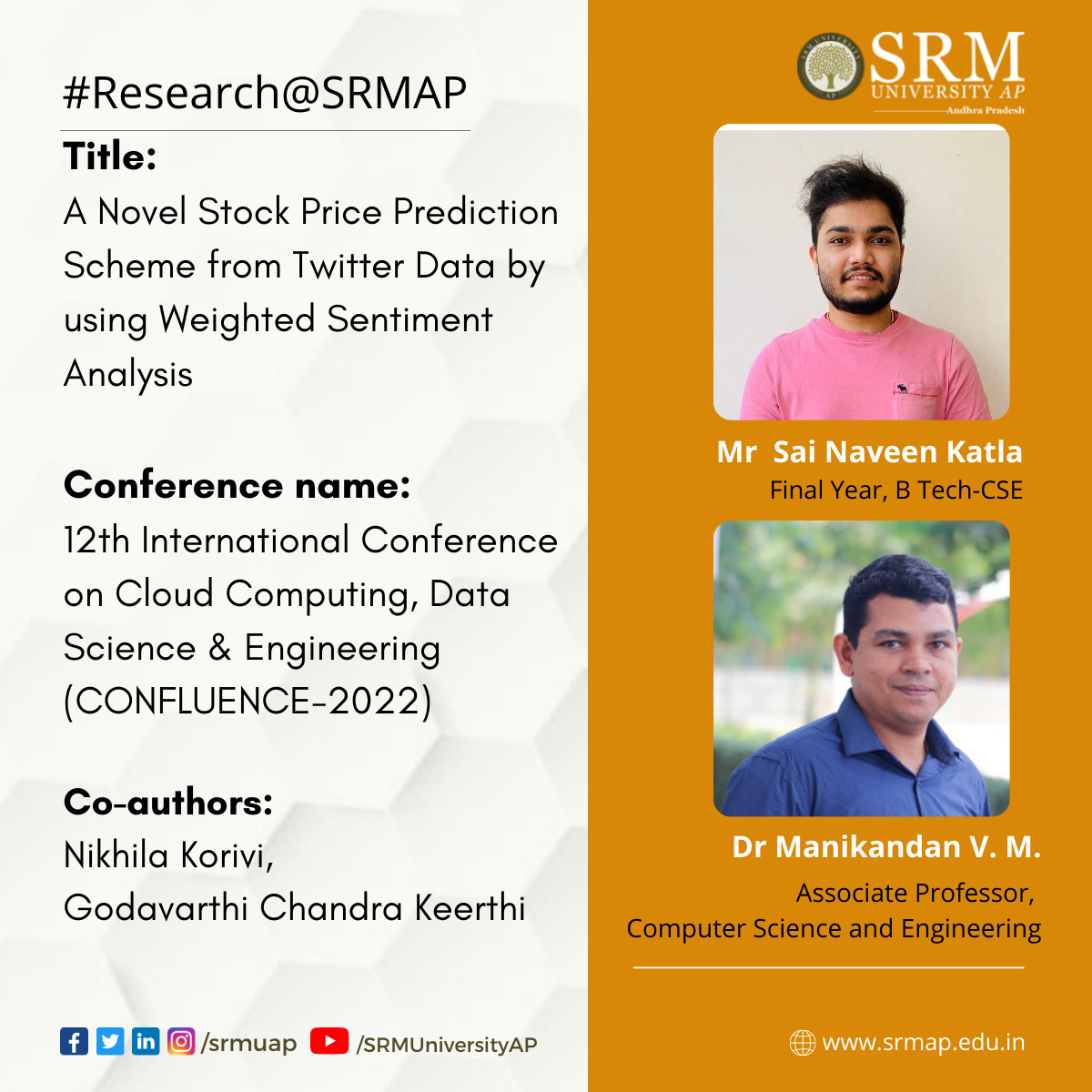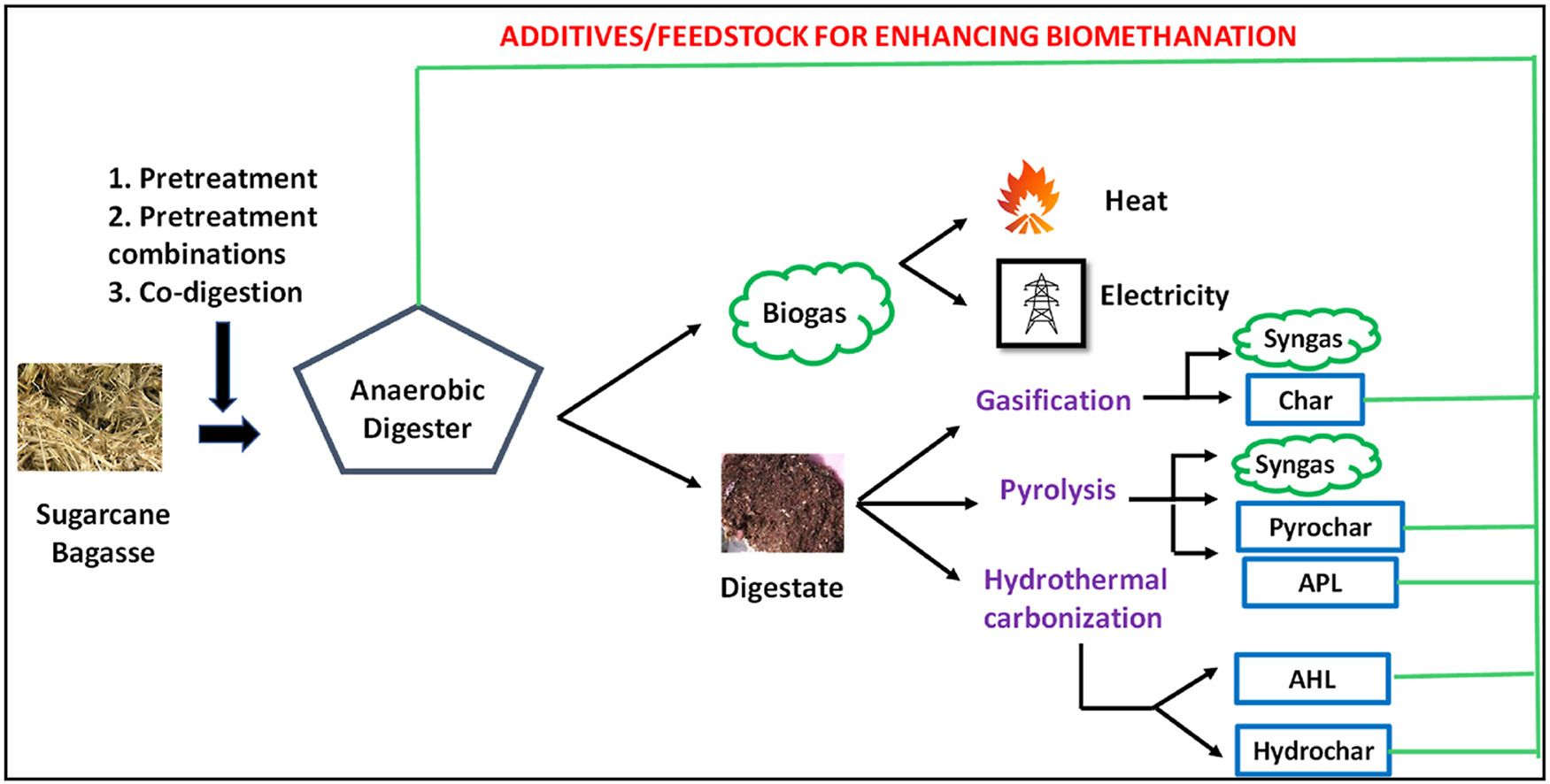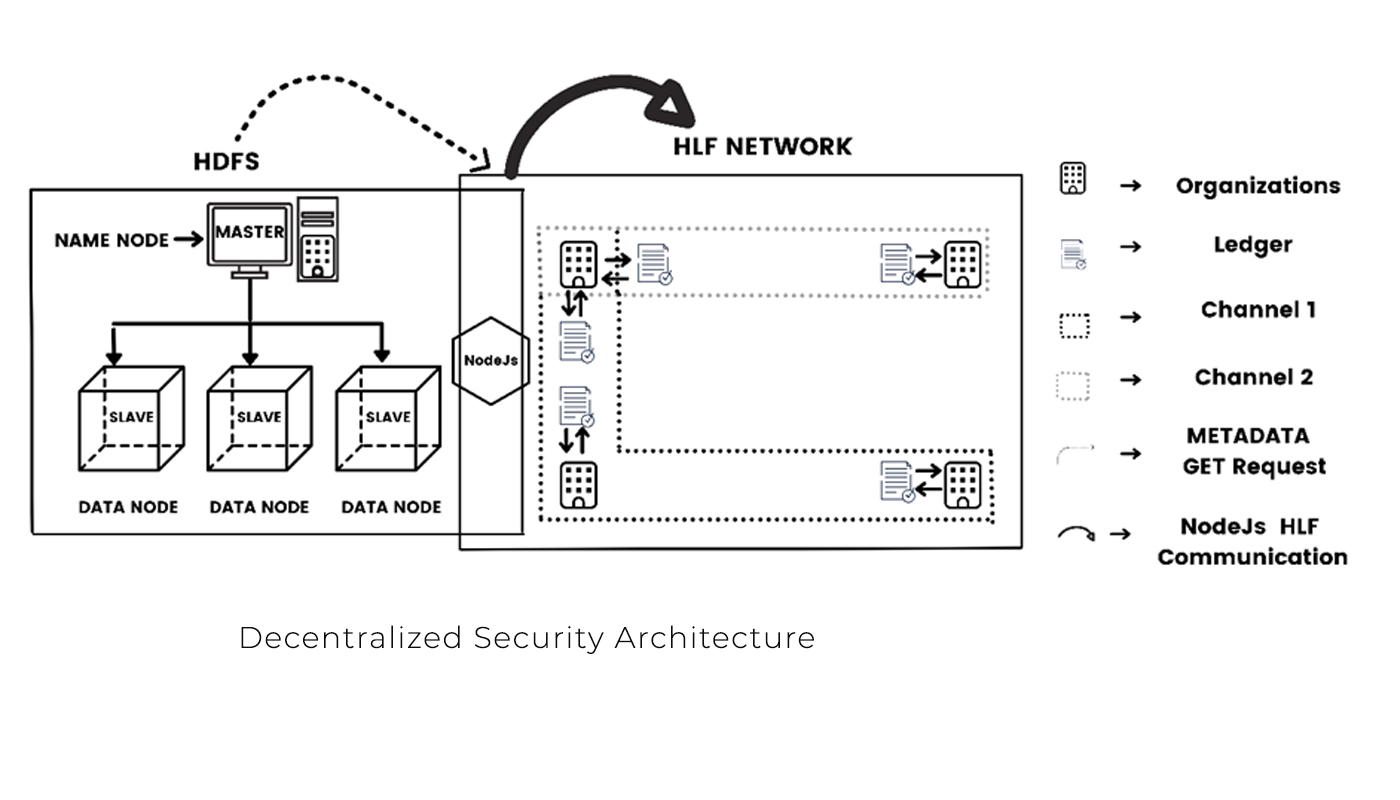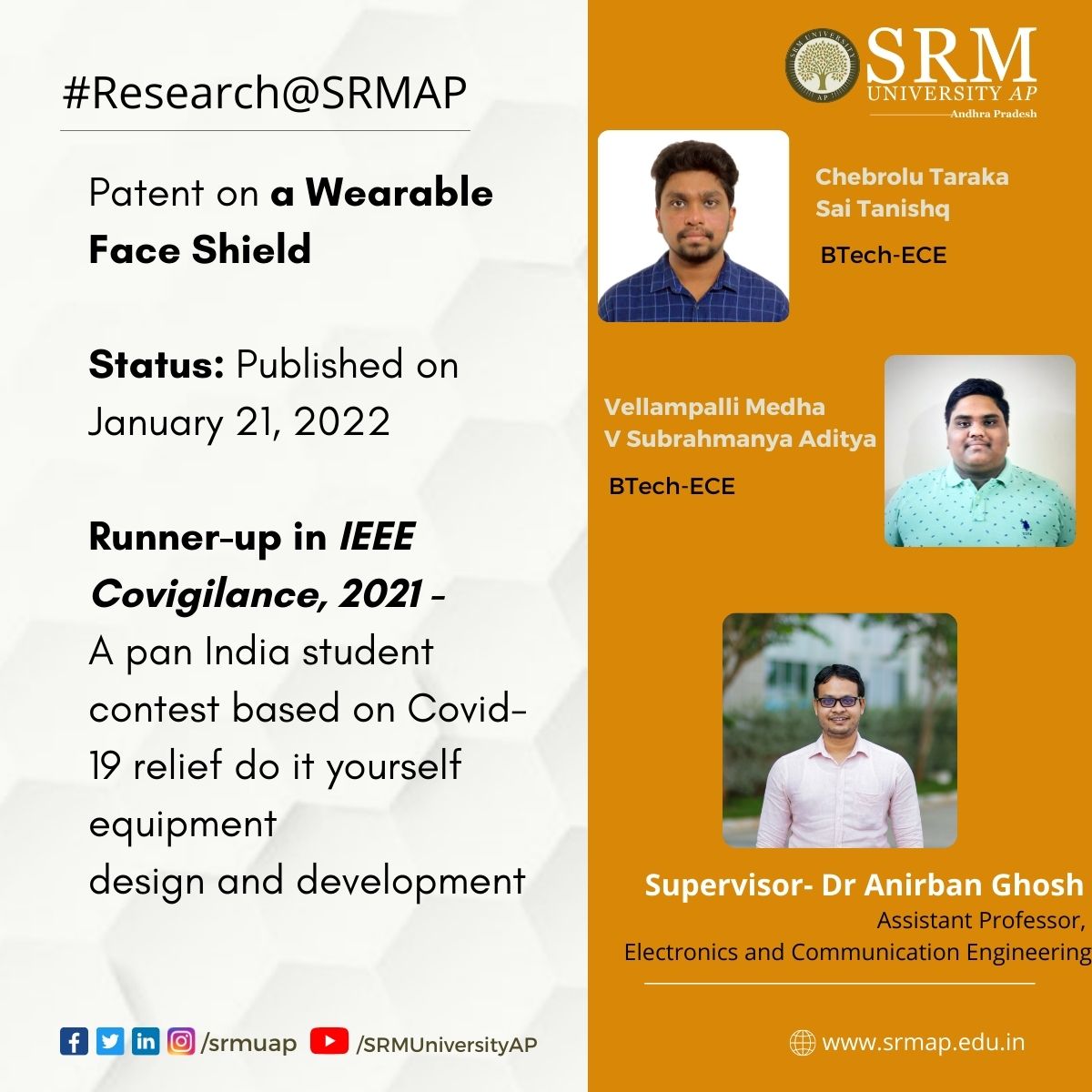Research News
- Effects of Covid-19 on mental health March 19, 2022
The Department of Economics is delighted to announce that Dr Ghanshyam Kumar Pandey and his research group; Sheeba Moghal, Rakshit Barodia, and William Carey have published an article titled “COVID-19 and its effects on the mental health of people living in urban slums in India” in the ‘Journal of Information and Knowledge Management’, having an Impact Factor of 1.3.
The study confirms that more than three-fourth of the population suffer from mental stress due to the spread of COVID-19 and the lockdown imposed by the government. Eighty per cent of those surveyed stated that the stress had affected their decision-making. The study also confirms that the number of dependents, monthly income, number of living rooms, maintenance of physical distancing norms, avoidance of social gatherings, government support, health insurance, and living in a rented house are significantly related to the mental stress of people living in slums in Andhra Pradesh in India.
Abstract of the Research
The COVID-19 pandemic has had a devastating effect on the mental health of people from different backgrounds; these effects have been particularly acute among lower-income households and in slums. There has been a steep rise in mental illness and behaviours associated with it since 2020, especially in slums characterized by poverty, poor housing, high density, and unhealthy environments. This paper aims to examine the effect of COVID-19 on the mental health of people living in the slums of Vijayawada and Visakhapatnam in the state of Andhra Pradesh in India.
- Novel method to optimise optical information transmission March 17, 2022
Mr D Lenin Babu from the Department of Electronics and Communication Engineering published his research “A Novel 8-Channel DWDM demultiplexer on Silicon Photonic Crystal slab: Design and Analysis” in Elsevier journal ‘Optik’, having an impact factor of 2.44. This research was carried out under the supervision of Dr Sreenivasulu Thupakula, Assistant Professor, Department of Electronics and Communication Engineering.
Abstract:
The published research presents a novel method to achieve optical information transmission at improved speed and reliability. Multiplexing and demultiplexing are the techniques used to enhance the information transmission rates and effective utilisation of channel bandwidths in communication systems. Dr Thupakula and Mr Lenin Babu proposed a new design with a minimised size of approximately 1mm and reduced information loss.
The team collaborated with the Applied Photonics Laboratory, Department of Electrical Communication Engineering, Indian Institute of Science, Bangalore, to conduct the research.
“The ongoing research is useful not only for communication applications but also for refractive index based sensing applications such as biosensing, Force sensing etc. Our future work includes Integrated optics-based antenna design for THz communication systems, Waveguide devices for sensing applications at THz wavelengths etc.,” said Dr Thupakula.
Continue reading → - Machine learning algorithms predict stock market trends March 17, 2022
Understanding stock market trends is crucial for investors to make key decisions. It was indeed a wonderful moment when Katla Sai Naveen from the Department of Computer Science and Engineering, presented a paper for the first time with an intelligent solution to that problem. The paper “A Novel Stock Price Prediction Scheme from Twitter Data by using Weighted Sentiment Analysis” was presented at the 12th International Conference on Cloud Computing, Data Science & Engineering (CONFLUENCE-2022), organised by Amity University, Noida, UP, India. It was co-authored by Nikhila Korivi, Godavarthi Chandra Keerthi under the mentorship of Dr V M Manikandan, Assistant Professor, Computer Science and Engineering. The paper will later be published in IEEE Xplore Digital Library.
Abstract:
Stock market forecasting is one of the most interesting research areas for many professionals and researchers. Economic conditions, investor sentiment, current events, future guidance, and a variety of other factors have an impact on the stock market. Since the stock market changes swiftly from time to time, it might be tough for a user or investor to keep up with the shifting trend. Combining sentiment analysis with a machine learning model, a solution to this problem has been introduced. Sentiment analysis is a text mining procedure that has one of the most important uses in analysing user reviews and evaluating the overall sentiment of a piece of text. The purpose of this research work is to create a machine learning model that takes recent tweets from the Twitter API and categorises each message as positive, bad, or neutral. Later, the impact of the person who wrote the tweet is also considered while predicting the trend. The parameters such as the total number of followers, the emotion of each comment on each post of selected stock, the number of likes and retweets are considered. An overview of the selected stock’s potential will be given to the user as the output.
This research will be useful for businessmen and people with enthusiasm for the stock market. The research will provide insights and intelligence to help make profitable decisions. False positives during sentiment analysis is a major concern in this domain. The team is focused on improving the existing approaches with better methods to identify false positives.
Continue reading → - A novel method of synthesising 2D transition metal oxide layers March 15, 2022
Patent application No: 202241005220
Publication date: 11/02/2022
Title: Two-Dimensional Transition Metal Oxide Layers and a method for their Synthesis
Inventors: Dr. Jatis Kumar Dash, Shaik Md. Abzal, Kurapati Kalyan, Sai Lakshmi Janga
Department of Physics, SRM-University-AP, Andhra PradeshThe Department of Physics is glad to announce that Dr Jatis Kumar Dash and his PhD Scholars Shaik Md. Abzal, Kurapati Kalyan and Sai Lakshmi Janga have got their patent “TWO-DIMENSIONAL TRANSITION METAL OXIDE LAYERS AND A METHOD FOR THEIR SYNTHESIS” published on February 11, 2022.
About the Patent
Extensive use of portable electronic products and the rapidly growing commercial markets in smart electric appliances have created a seemingly high demand for flexible, wearable high-performance photoelectric devices and energy storage technology. In the search for new materials to meet these criteria, one promising solution may be the two-dimensional (2D) material heterostructures, assembled by stacking different conventional 2D materials (for example, graphene, transition metal oxides, carbides, and chalcogenides) in hetero-layered architectures.
These 2D materials stackings are ultrathin layered crystals that show unusual physicochemical properties at few-atom thickness. These 2D heterostructures offer several key advantages for the next-generation devices such as (i) atomically thin 2D nanosheets provide a larger surface area due to complete exposure of the surface atoms, (ii) the edge sites in 2D nanosheets are chemically more reactive than their basal planes and the open gaps enable the intercalation of electrolyte ions and (iii) the high mechanical strength and flexibility at atomic dimensions allow them to be used in the next-generation wearable electronics.
But the growth and stacking of 2D materials is always a challenge. Also, the existing growth tools are complex and expensive. Here, at SRM University-AP, we have fabricated the large-area ultra-thin 2D transition metal oxide (TMO) layers using an easy and cost-effective method. In addition, these 2D TMO layers are further integrated to different other 2D materials for their use in nano-electronic devices. Our work shows the great potential of ultra-thin TMOs in 2D-material-based flexible electronics.
Social Implication
2D materials are the prime candidates for making flexible, wearable, foldable and transparent self-powered smart electronic devices. The next-generation smart electronic devices will be made of 2D materials heterostructures which will need less operating power, less consumption of materials and will have ultimate scalability.
The team is also in the process of optimization and aims to make prototype flexible 2D supercapacitors, photodetectors, ultrathin transistors, and various sensors.
- Innovatory conversion of bagasse to biogas March 15, 2022
The Department of Environmental Science is glad to announce that Dr Lakhveer Singh has published a paper titled “Anaerobic digestion of sugarcane bagasse for biogas production and digestate valorization” in the journal ‘Chemosphere’ having an impact factor of 7.08 in collaboration with IIT Delhi.
Abstract of the Research
The complex structure of biomass is recalcitrant to degradation and is a major hindrance for anaerobic digestion, so different pre-treatment methods are applied to deconstruct the bagasse for microbial digestion. In this review, different processes developed for the pre-treatment of bagasse and their effect on biogas production have been extensively covered. Moreover, combinations of pre-treatment methods, co-digestion of bagasse with other waste (nitrogen-rich or easily digestible) for enhanced biogas production and biomethane generation along with other value-added products have also been reviewed. Thus, this review highlights the major emerging area of research for improvement in bagasse-based processes for enhanced biogas production along with digestate valorization to make the overall process economical and sustainable.
The paper offers a promising solution with respect to the conversion of agricultural waste to biomethane along with other value-added products. As far as Dr Singh is concerned, future research should also be directed towards the life cycle assessment of different integrated technologies for quantifying the environmental and economic benefits which will help to choose the most sustainable option for digestate valorization.
- Introducing decentralized security system using blockchain technology March 10, 2022
The Department of Computer Science and Engineering is delighted to announce that Dr Rajiv Senapati and his research group; Abhiram Chakravadhanula, Jaswanth Kolisetty, Karthik Samudrala and Bharat Preetham have published a research article titled “A Novel Decentralized Security Architecture for the Centralized Storage System in Hadoop using Blockchain Technology” in the Scopus indexed IEEE 7th I2CT (The premier conference for the latest discoveries in Convergence in Technology in Asia Pacific).
Over the past decades, the Big Data ecosystem is experiencing a humungous explosion in the generation and exchange of information. Trading such delicate information can serve as a profitable knowledge resource in the present economy. However, serious concerns have been raised about the security and assurance of delicate data as the conventional safety architecture in centralized storage systems does not meet its nuanced requirements. Blockchain technology offers a promising solution for big data protection due to its decentralized nature. Through this research article, Dr Rajiv Senapati and his students intend to introduce a decentralized security architecture in centralized storage systems such as Hadoop to address its existing vulnerabilities.
Abstract of the Research
Big Data is huge in volume, diverse in information, and growing at flourishing rates. The major distributed file systems in the current market in Big Data Analysis include Apache Hadoop, Storm, Cassandra, Flink, Cloudera, and many more. Hadoop is an open-source framework divided into Hadoop Distributed File System (HDFS) and Map-Reduce. Hadoop plays a leading role in storing and processing Big Data in contemporary society as it is cost-effective and can manage large volumes of data in low-cost commodity hardware. HDFS is a type of Data Warehouse which is scalable and has fast access to information.
Metadata is the information about the data, such as which block is storing on what datanode, how many replications that block has, and on which datanodes those replications reside. In HDFS, this metadata is stored at a fixed place in namenode, and attackers can access the metadata and modify it without notice. Also, metadata is mutable, which means the attacker can erase his presence easily.
In this paper, to resolve this issue, we have provided a mechanism using blockchain technology that follows a decentralized architecture against the centralized architecture followed by HDFS. Hyperledger Fabric (HLF) is the blockchain proposed to be effective and trusted for such a purpose. HLF is a private blockchain with a distributed immutable ledger. The metadata will be stored in the ledger. If an attacker tries to modify the data, he cannot erase his presence as the ledger is immutable, unlike HDFS. Further, the work proposed in this paper can be extended in real-time HDFS with a secure ledger and multiple nodes.
- A Wearable Face Shield: Pioneering engineering invention March 5, 2022
The Department of Electronics and Communication Engineering is proud to announce the remarkable achievement of the students Chebrolu Taraka Sai Tanishq and Vellampalli Medha V Subrahmanya Aditya. They have designed a wearable face shield and secured the second position in IEEE Covigilance, 2021 – A pan India student contest based on Covid-19 relief do it yourself equipment design and development, under the guidance of Dr Anirban Ghosh, and got a patent published for their prototype developed as part of the competition. The team also participated in the 4th Research Day organized by SRM University-AP and received a gold medal.
The prototype was submitted in the design competition on July 30, 2021, and after 40 days of rigorous brainstorming, component procurement and prototype development, the final model was submitted for evaluation. Based on prototype execution, feasibility of manufacturing and suitability of the model to contain the spread of the pandemic, the team secured second place in the Pan India contest, and it was deemed fit to address the two criteria; innovation challenges like Innovation of homemade masks/shields/PPEs and innovation of a feasible solution to control covid-19 spread while the schools and colleges are reopening. Further, this prototype was submitted to the patent office under the name “A Wearable Face Shield” (Application no:202241000990) and the patent was published on January 21, 2022.
Their accomplishment bears testimony to the fact that unflinching determination towards your goals and consistent efforts to make them come true will always pay off. Designing a wearable face shield is a well-timed innovation as the pandemic shows no sign of retreat and face shield has become one of the daily necessities of all mankind.
About the Prototype
The wearable face shield is a medical protective device, and it comprises a frame for securing the shield to the head of a wearer, a transparent sheet extending from the frame, a detection circuit that is mounted on the frame, a switch, and a battery module. The detection circuit comprises of a control unit that processes the sensed data received from proximity and temperature sensors to generate output signals and an alerting unit that comprises LEDs, buzzer and it provides an indication of– (i) the presence of a detected external object within a pre-determined distance of the wearer (ii) the sensed body temperature of the wearer. The alerting unit is placed strategically to alert people via visual and audio signals respectively.
Such precautionary detection and proximity alert prototype can prove instrumental in early diagnosis and isolation aiding in crowd management and free movement in places of social gathering. Hence, a wearable face shield ensures adequate separation between persons and facilitates temperature monitoring and early detection of disease.
They are currently working on a project called “Human Monitoring System” (HUM). It is an all-pervasive system designed to measure and keep track of the heartbeat, blood pleasure, temperature, location, Spo2 level etc of the user. In the event of an emergency or critical drop in any of the vitals, the system can automatically alert the local hospital, ambulance service and relatives.
- High-quality perovskite nanocrystals for light-emitting applications March 5, 2022
 Dr Nimai Mishra, Assistant Professor, Department of Chemistry, SRM University-AP, Andhra Pradesh, along with his research group comprising of students pursuing PhD under his supervision, Ms VG Vasavi Dutt, Mr Syed Akhil, Mr Rahul Singh, and Mr Manoj Paalabathuni have published a research article titled “High-Quality CsPbX3 (X = Cl, Br, or I) Perovskite Nanocrystals Using Ascorbic Acid Post-Treatment: Implications for Light-Emitting Applications” in the Journal “ACS Applied Nano Materials” (published by The American Chemical Society) having an impact factor of ~5.1.
Dr Nimai Mishra, Assistant Professor, Department of Chemistry, SRM University-AP, Andhra Pradesh, along with his research group comprising of students pursuing PhD under his supervision, Ms VG Vasavi Dutt, Mr Syed Akhil, Mr Rahul Singh, and Mr Manoj Paalabathuni have published a research article titled “High-Quality CsPbX3 (X = Cl, Br, or I) Perovskite Nanocrystals Using Ascorbic Acid Post-Treatment: Implications for Light-Emitting Applications” in the Journal “ACS Applied Nano Materials” (published by The American Chemical Society) having an impact factor of ~5.1.Abstract:
Cesium lead halide perovskite nanocrystals (CsPbX3 PNCs) have been the flourishing area of research in the field of photovoltaic and optoelectronic applications because of their excellent optical and electronic properties. However, they suffer from low stability and deterioration of photoluminescence (PL) properties post-synthesis. One of the ways to minimize the surface defects in the surface treatment with suitable ligands is to achieve the PNCs with superior PL properties for light-emitting applications.
In this article, Dr Mishra’s research group addressed the issue of stability in PNCs. We demonstrate to achieve high photoluminescence and stability of CsPbX3 PNCs by incorporating ascorbic acid via post-treatment as a new capping ligand that is abundantly available. Upon addition of ascorbic acid as surface passivation ligand into the oleic acid/oleylamine system to get near-unity photoluminescence quantum yield (PLQY) of CsPbBr3, CsPb(Br/I)3, and for CsPbI3 perovskite NCs. Maintaining stability has become the hotspot of research in this field. Hence, as-a-proof of concept, the stability studies of PNCs in ambient conditions, under continuous UV irradiation, and PL with temperature variations are put forth here. The stability enhancement with post-treatment of ascorbic acid is highly reproducible as we tested for four batches of samples.
Despite the significant advancements of PNCs, there is a challenge afflicting the stability of CsPbI3 PNCs. They are thermodynamically unstable and undergo a non-perovskite phase (δ-phase) transition at room temperature. Many efforts have been reported in the stabilization of iodide perovskite NCs by critically passivating PNCs and applying them for optoelectronics and photovoltaics. On the other hand, mixed halide perovskites like CsPbBrI2 which are relatively stable than CsPbI3 PNCs are a better choice for device applications. But, photo-induced halide segregation is unavoidable which in turn again limit their usage in practical applications. In this manuscript, we demonstrated that the ultra-stable iodide-based PNCs can be achieved by simple and facile surface treatment with ascorbic acid.
The PL intensity of untreated and ascorbic acid-treated PNCs is recorded for 42 days since the date of synthesis. The measurements are carried out for 4 different batches of samples to ensure reproducibility. It is found that the PL intensity is deteriorating rapidly for untreated PNCs while the PL intensity is largely maintained for ascorbic acid treated PNCs. Nearly ̴72% of the initial PL intensity is maintained even after 42 days for the ascorbic acid-treated CsPbBr3 PNCs while the PL intensity is dropped to 24% for untreated PNCs. Ascorbic acid treated CsPbBrI2 PNCs exhibited exceptional ambient stability where ̴69% of the initial PL intensity is maintained after 42 days while the PL of untreated CsPbBrI2 PNCs is degraded rapidly within 2 weeks from the date of synthesis. Moreover, the PL stability of CsPbI3 PNCs is high for ascorbic acid-treated samples even after 55 days while the PL has deteriorated within 4 days for untreated CsPbI3 PNCs. The PL of untreated CsPbI3 PNCs is completely lost in the first 4 hours of UV illumination while ̴ 76.7% remnant PL is observed for ascorbic acid-treated CsPbI3 PNCs. We believe the stabilization of CsPbX3 PNCs of different halide compositions via simple surface treatment with ascorbic acid could form a basis for futuristic light-emitting applications.
Read the full paper: https://pubs.acs.org/doi/full/10.1021/acsanm.1c04312
Continue reading → - SRMAP Scholar wins best oral presentation award in International Conference March 4, 2022
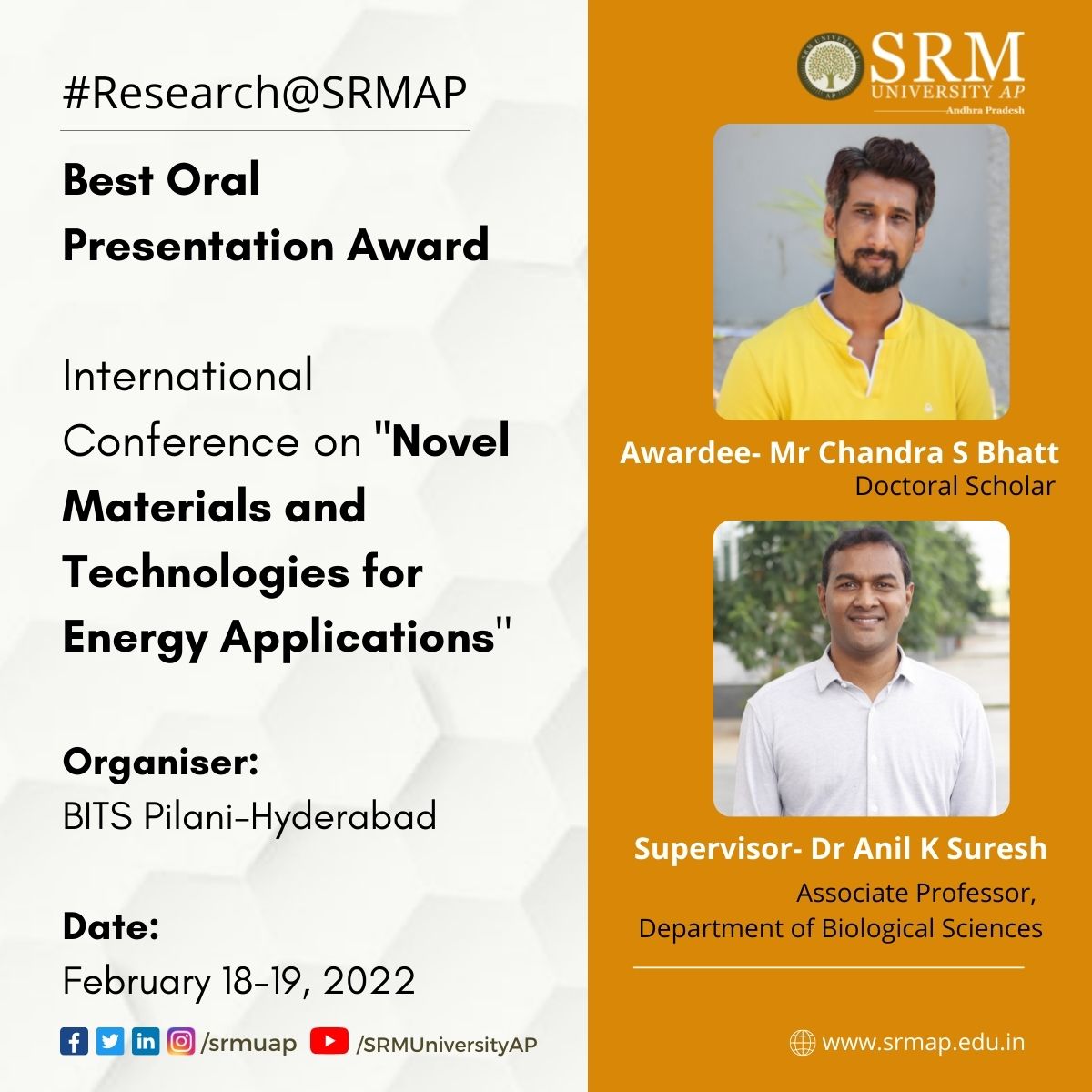 Mr Chandra S Bhatt, a PhD Scholar (CSIR-JRF) working under the guidance of Dr Anil K Suresh, Associate Professor, Department of Biological Sciences, has won the Best Oral Presentation Award at the International Conference on “Novel Materials and Technologies for Energy Applications,” organised by BITS Pilani-Hyderabad, on February 18-19, 2022. Prof Ashutosh Sharma, Former DST Secretary & Institute Chair Professor, IIT Kanpur, was the Chief Guest of the Conference.
Mr Chandra S Bhatt, a PhD Scholar (CSIR-JRF) working under the guidance of Dr Anil K Suresh, Associate Professor, Department of Biological Sciences, has won the Best Oral Presentation Award at the International Conference on “Novel Materials and Technologies for Energy Applications,” organised by BITS Pilani-Hyderabad, on February 18-19, 2022. Prof Ashutosh Sharma, Former DST Secretary & Institute Chair Professor, IIT Kanpur, was the Chief Guest of the Conference.Abstract:
Mr Bhatt’s project aims to develop the best out of waste, which is practically demonstrated by synthesising gold nanostructured eggshell-based supported catalyst. Besides this novel strategy, the megacatalyst is implemented in the real-time degradations of organic and sewage dyes that are harmful to the environment and hydrogenation of nitroarenes at gram-scale (precursors for various pharmaceutical ingredients). Our rationale, naturally created, stable, reusable, hand-removable, resilient catalyst developed from left-over food waste trounces the majority of the existing challenges while utilising nano-based catalysts for heterogeneous catalysis.
With this innovation, Mr Bhatt aims to demonstrate pilot-scale (100-1000 litre) batch catalytic reactions for real-time textile sewage dye detoxification and gram scale hydrogenation of pharma-precursor for the production of acetaminophen, as a step of validation for immediate technology transfer and commercialisation for both environmental remediation and active pharmaceutical ingredients (API’s).
About the Author:
Mr Bhatt aims to continue his scientific career as a prominent scientist in the interdisciplinary area of nano-immunology for cancer theragnostics. Therefore, after the completion of his PhD, he wishes to advance his research career to contribute further to the realm of science upon postdoctoral training from a top-ranking institution abroad.
“It is indeed a moment of pride for me to be awarded the Best Oral Presentation Award in an International Conference organised by BITS Pilani, Hyderabad, winning over 30 participants across the Nation. I express my heartfelt gratitude to my supervisor Dr Anil K Suresh, for his guidance and motivation me throughout the journey,” said Mr Bhatt.
While expressing his joy, Dr Suresh emphatically said, “This was his first oral presentation in an International Conference, and he was conferred with the “Best Oral Presentation” Award. This recognition speaks for Chandra Sekhar’s dedication to his research. He has been working enthusiastically on this project, and I wish that the paper gets published in a high-impact journal which has already been communicated for Shekar’s bright scientific career.”
Continue reading → - AI to boost up the performance of bioelectrochemical systems March 3, 2022
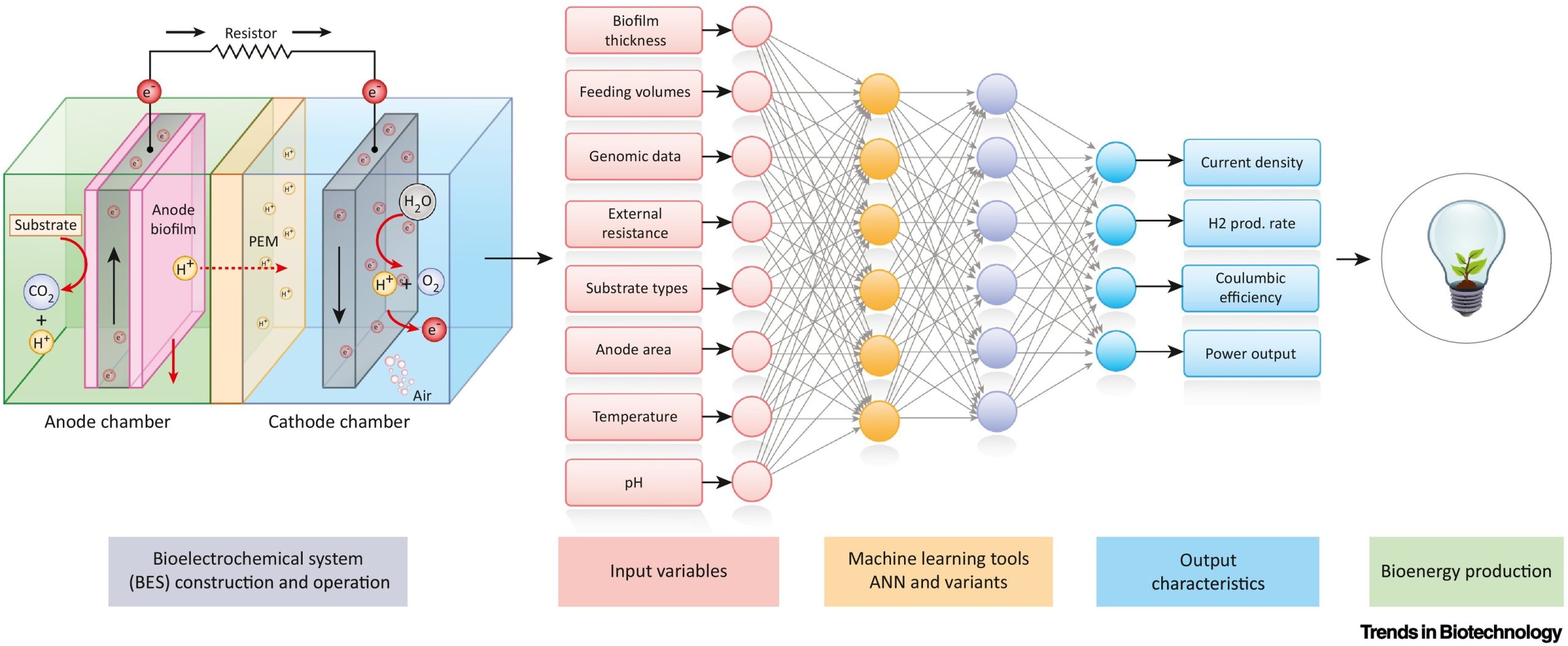
The Department of Environmental Science is glad to announce that Dr Lakhveer Singh has published his paper titled, “Leveraging artificial intelligence in bioelectrochemical systems” in a prestigious journal Trends in Biotechnology with a high Impact Factor of 19.53.
The paper was published in collaboration with Baptist University, Hong Kong and Oregon State University, USA.
Abstract of the Research
Bioelectrochemical systems (BESs) are highly evolved and sophisticated systems that produce bioenergy via exoelectrogenic microbes. Artificial intelligence (AI) helps to understand, relate, model, and predict both process parameters and microbial diversity, resulting in higher performance. This approach has revolutionised BESs through highly advanced computational algorithms that best suit the systems’ architecture for suitable fuel production.
About the Research
The performance of the microbial reactors primarily depends on the activity of the biocatalysts, indirectly governed by the microbial community structure and function. In this context, microbial dynamics are crucial for performance consistency and are sensitive to both biotic and abiotic stress in the reactor. To address this, a comprehensive, mechanistic understanding of the community dynamics is essential. Understanding the metabolic and electrochemical potentials would provide a basis for the selection and control of efficient communities with ramped metabolic flux and boosted electrogenic activity. The research will help in the development of an improved system for green fuel production.
According to Dr Lakhveer Singh and his collaborators, Artificial Neural Networks (ANNs) and Adaptive Neuro-fuzzy Systems (ANFISs), backed with iterative and backpropagation abilities, can be applied to Microbial Fuel Cells (MFCs) with improved computational models. This will eventually provide a breakthrough in operational and translational research predicting newer parameters, such as predictions of the emergence of substrate-specific microbial communities in biosensors or bioreactors. They intend to work on this in future.


